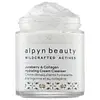What's inside
What's inside
 Key Ingredients
Key Ingredients

 Benefits
Benefits

 Concerns
Concerns

 Ingredients Side-by-side
Ingredients Side-by-side

Water
Skin ConditioningSesamum Indicum Seed Oil
EmollientCaprylic/Capric Triglyceride
MaskingButyrospermum Parkii Butter
Skin ConditioningCetearyl Glucoside
EmulsifyingCarrageenan
Glycerin
HumectantCaprylhydroxamic Acid
Caprylyl Glycol
EmollientSodium PCA
HumectantCamellia Sinensis Leaf Extract
AntimicrobialSimmondsia Chinensis Seed Oil
EmollientSqualene
EmollientMacadamia Ternifolia Seed Oil
EmollientYeast Extract
Skin ConditioningGlucosamine Hcl
Tocopherol
AntioxidantSodium Hyaluronate
HumectantAlgae Extract
EmollientOrchid Extract
Skin ConditioningTitanium Dioxide
Cosmetic ColorantWater, Sesamum Indicum Seed Oil, Caprylic/Capric Triglyceride, Butyrospermum Parkii Butter, Cetearyl Glucoside, Carrageenan, Glycerin, Caprylhydroxamic Acid, Caprylyl Glycol, Sodium PCA, Camellia Sinensis Leaf Extract, Simmondsia Chinensis Seed Oil, Squalene, Macadamia Ternifolia Seed Oil, Yeast Extract, Glucosamine Hcl, Tocopherol, Sodium Hyaluronate, Algae Extract, Orchid Extract, Titanium Dioxide
Water
Skin ConditioningHelianthus Annuus Seed Oil
EmollientCetyl Alcohol
EmollientGlycerin
HumectantCetearyl Alcohol
EmollientCetearyl Olivate
Sorbitan Olivate
EmulsifyingTheobroma Cacao Seed Butter
EmollientPropanediol
SolventKaolin
AbrasiveDecyl Glucoside
CleansingBakuchiol
AntimicrobialCollagen
MoisturisingJojoba Esters
EmollientAmelanchier Alnifolia Fruit Extract
Skin ConditioningSclerotium Gum
Emulsion StabilisingCetearyl Glucoside
EmulsifyingCaprylyl Glycol
Emollient1,2-Hexanediol
Skin ConditioningSodium Lauroyl Sarcosinate
CleansingAcacia Senegal Gum
MaskingXanthan Gum
EmulsifyingCitric Acid
BufferingEucalyptus Globulus Leaf Oil
PerfumingTremella Fuciformis Polysaccharide
Emulsion StabilisingSalicylic Acid
MaskingMenthol
MaskingSimmondsia Chinensis Seed Oil
EmollientGlucose
HumectantIron Oxides
CI 77491
Cosmetic ColorantCaprylic/Capric Triglyceride
Masking3-O-Ethyl Ascorbic Acid
Skin ConditioningPistacia Lentiscus Gum
MaskingHydrogenated Lecithin
EmulsifyingPhenethyl Alcohol
MaskingEthylhexylglycerin
Skin ConditioningWater, Helianthus Annuus Seed Oil, Cetyl Alcohol, Glycerin, Cetearyl Alcohol, Cetearyl Olivate, Sorbitan Olivate, Theobroma Cacao Seed Butter, Propanediol, Kaolin, Decyl Glucoside, Bakuchiol, Collagen, Jojoba Esters, Amelanchier Alnifolia Fruit Extract, Sclerotium Gum, Cetearyl Glucoside, Caprylyl Glycol, 1,2-Hexanediol, Sodium Lauroyl Sarcosinate, Acacia Senegal Gum, Xanthan Gum, Citric Acid, Eucalyptus Globulus Leaf Oil, Tremella Fuciformis Polysaccharide, Salicylic Acid, Menthol, Simmondsia Chinensis Seed Oil, Glucose, Iron Oxides, CI 77491, Caprylic/Capric Triglyceride, 3-O-Ethyl Ascorbic Acid, Pistacia Lentiscus Gum, Hydrogenated Lecithin, Phenethyl Alcohol, Ethylhexylglycerin
 Reviews
Reviews

Ingredients Explained
These ingredients are found in both products.
Ingredients higher up in an ingredient list are typically present in a larger amount.
This ingredient is an emollient, solvent, and texture enhancer. It is considered a skin-softener by helping the skin prevent moisture loss.
It helps thicken a product's formula and makes it easier to spread by dissolving clumping compounds.
Caprylic Triglyceride is made by combining glycerin with coconut oil, forming a clear liquid.
While there is an assumption Caprylic Triglyceride can clog pores due to it being derived from coconut oil, there is no research supporting this.
Learn more about Caprylic/Capric TriglycerideCaprylyl Glycol is a humectant and emollient, meaning it attracts and preserves moisture.
It is a common ingredient in many products, especially those designed to hydrate skin. The primary benefits are retaining moisture, skin softening, and promoting a healthy skin barrier.
Though Caprylyl Glycol is an alcohol derived from fatty acids, it is not the kind that can dry out skin.
This ingredient is also used as a preservative to extend the life of products. It has slight antimicrobial properties.
Learn more about Caprylyl GlycolCetearyl Glucoside is a surfactant and emulsifier. It can be produced from synthetic of natural sources of cetearyl alcohol and glucose.
Emulsifiers help prevent ingredients from separating, such as oils and waters. It can also be used to enhance the texture of products.
As a surfactant, Cetearyl Glucoside helps during the cleansing process. By gathering all the dirt and oils, it allows these molecules to be washed away easily.
Learn more about Cetearyl GlucosideGlycerin is already naturally found in your skin. It helps moisturize and protect your skin.
A study from 2016 found glycerin to be more effective as a humectant than AHAs and hyaluronic acid.
As a humectant, it helps the skin stay hydrated by pulling moisture to your skin. The low molecular weight of glycerin allows it to pull moisture into the deeper layers of your skin.
Hydrated skin improves your skin barrier; Your skin barrier helps protect against irritants and bacteria.
Glycerin has also been found to have antimicrobial and antiviral properties. Due to these properties, glycerin is often used in wound and burn treatments.
In cosmetics, glycerin is usually derived from plants such as soybean or palm. However, it can also be sourced from animals, such as tallow or animal fat.
This ingredient is organic, colorless, odorless, and non-toxic.
Glycerin is the name for this ingredient in American English. British English uses Glycerol/Glycerine.
Learn more about GlycerinThis oil comes from the seeds of the desert shrub called Jojoba. It is more commonly known as jojoba oil, a non-comedogenic oil.
Jojoba oil does not contain fragrance and has many fatty-acids, making it a great soothing ingredient.
It also contains Vitamin E, a great moisturizing ingredient. Vitamin E is also an antioxidant and protects your skin against oxidative damage.
This ingredient humectant properties, meaning it helps draw moisture from the air. This helps keep your skin hydrated.
While jojoba has antibacterial properties, it is only able to kill some strains of bacteria.
Studies also show it helps in wound healing. In fact, Indigenous cultures have used jojoba as a moisturizer and to help treat burns for centuries.
Fun fact: Jojoba oil similar to natural human skin sebum, so it has a great effect on dry skin. It is also promising with helping to regulate sebum production.
Due to its fatty acid content, Jojoba oil may not be fungal acne safe. We recommend speaking with a professional if you have any concerns.
Learn more about Simmondsia Chinensis Seed OilWater. It's the most common cosmetic ingredient of all. You'll usually see it at the top of ingredient lists, meaning that it makes up the largest part of the product.
So why is it so popular? Water most often acts as a solvent - this means that it helps dissolve other ingredients into the formulation.
You'll also recognize water as that liquid we all need to stay alive. If you see this, drink a glass of water. Stay hydrated!
Learn more about Water